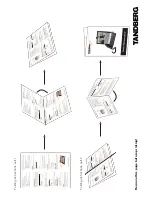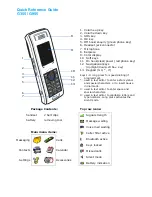
Section 3: Features
Product Description
115
3
●
First Digit Absorption
A tie line can ignore (absorb) the first digit received, which helps when setting up a tie line
network. For example, your system can have tie lines to two other systems with the same
extension numbering plan. Use the first digit to differentiate between the systems. Tie line
callers can dial 3200-3456 for the first system’s extensions and 4200-4456 for the second sys-
tem’s extensions. The receiving system ignores the first digit and routes calls correctly to the
extension dialed (i.e., 4301 is received as 301).
●
Trunk Group Routing/ARS Access
When a tie line user calls the remote system, they may be able to dial 9 and place outside calls
through the remote system. Any toll charges are incurred by the remote system. The call follows
the remote system’s Trunk Group Access or Automatic Route Selection - whichever is enabled
●
Trunk Group Access
Tie line callers may be able to access trunk groups in the remote system by dialing Program-
mable Function Key *02 and the trunk group number. This allows the callers to select a spe-
cific trunk group for an outgoing call. Trunk Group Access bypasses the remote system’s
Trunk Group Routing/ARS. As with dial 9 access, any toll charges are incurred by the remote
system.
●
Common Abbreviated Dialing
The remote system’s Common Abbreviated Dialing bins may be available to tie line callers. Use
this capability to set up centralized Abbreviated Dialing control - or just save time when dialing.
●
Operator Calling
A tie line caller may be able to dial 0 for the remote system’s operator.
●
Paging
Internal and External Paging may be available to tie line callers. This allows co-workers in adja-
cent facilities connected by tie lines, for example, to broadcast announcements to each other.
●
Direct Trunk Access
This option allows tie line callers to directly access a trunk for an outside call by dialing #9
and the trunk’s number. Like Trunk Group Access, this bypasses the remote system’s Trunk
Group Routing/ARS. Any toll charges are incurred by the remote system.
●
Forced Trunk Disconnect
The Forced Trunk Disconnect option allows a tie line caller to disconnect (release) another
extension’s active outside call. The tie line caller can then place a call on the released trunk.
Tie line callers should use Forced Trunk Disconnect only in an emergency, when no other
trunks are available.
●
DISA/Tie Trunk Barge In
The DISA/Tie Trunk Barge In option allows a tie line caller to break into another extension’s
established call. This sets up a three-way conversation between the intruding party and the
two parties on the initial call.
Tie Line Outgoing Call Restriction
You can selectively deny incoming tie lines access to your system’s outgoing trunk groups. Incom-
ing tie line callers could be able to access your outgoing WATS lines, for example, but not your
DDD trunks. The system allows you to set up a restriction matrix for each of your incoming tie
lines - for each of your outgoing trunk groups.
















































